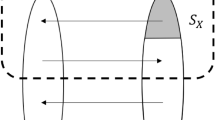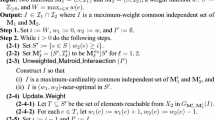Abstract
In this paper, we present an O(r 4 n) algorithm for the linear matroid parity problem. Our solution technique is to introduce a modest generalization, the non-simple parity problem, and identify an important subclass of non-simple parity problems called ‘easy’ parity problems which can be solved as matroid intersection problems. We then show how to solve any linear matroid parity problem parametrically as a sequence of ‘easy’ parity problems.
In contrast to other algorithmic work on this problem, we focus on general structural properties of dual solutions rather than on local primal structures. In a companion paper, we develop these ideas into a duality theory for the parity problem.
Similar content being viewed by others
References
N. Christofides, “The travelling salesman problem,” in: N. Christofides, A. Mingozzi, P. Toth and Sandi, eds.,Combinatorial Optimization (Wiley, New York, 1979) pp. 131–150.
K.A. Clements, P.W. Davis and G.R. Krumpholz, “Critical members of matroid intersections and critical branches in electric power systems,” contributed paper at:The Third SIAM Conference on Discrete Mathematics, Clemson University (Clemson, SC, 1986).
G. Cornuéjols, “General factors in graphs,” GSIA, Carnegie-Mellon University (Pittsburgh, PA, 1986).
G. Cornuéjols and D. Hartvigsen, “An extension of matching theory,”Journal of Combinatorial Theory Series B 40 (1986) 285–296.
G. Cornuéjols and W.R. Pulleyblank, “Perfect triangle-free 2-matchings,”Mathematical Programming Study 13 (1980) 1–7.
G. Cornuéjols and W.R. Pulleyblank, “Critical graphs, matchings and tours or a hierarchy of relaxations for the travelling salesman problem,”Combinatorica 3 (1983) 35–52.
J. Edmonds, “Paths, trees and flowers,”Canadian Journal of Mathematics 17 (1965a) 449–467.
J. Edmonds, “Maximum matching and a polyhedron with 0,1-vertices,”Journal of Research of the NBS 69B (1965b) 125–130.
J. Edmonds, “Matroids and the greedy algorithm,”Mathematical Programming 1 (1971) 127–136.
M. Fujii, T. Kasami and K. Ninomiya, “Optimal sequencing of two equivalent processors,”SIAM Journal on Applied Mathematics 17 (1969) 784–789.
H.N. Gabow and M. Stallmann, “An augmenting path algorithm for linear matroid parity,”Combinatorica 6 (1986) 123–150.
R. Giles, “Optimum matching forests I: Special weights,”Mathematical Programming 22 (1982) 1–12.
R.E. Gomory and T.C. Hu, “Multi-terminal network flows,”Journal of the Society for Industrial and Applied Mathematics 9 (1961) 551–570.
B. Korte and P. Jensen, “Complexity of matroid property algorithms,”SIAM Journal on Computing 11 (1982) 184–190.
E. Lawler, “Matroids with parity conditions: A new class of combinatorial optimization problems,” Memorandum Number ERL-M334, Electronics Research Laboratory (Berkeley, CA, 1971).
E. Lawler, “Matroid intersection algorithms,”Mathematical Programming 9 (1975) 31–56.
E. Lawler,Combinatorial Optimization: Networks and Matroids (Holt, Reinhart and Winston, New York, 1976).
L. Lovász, “Matroidal matching and some applications,”Journal of Combinatorial Theory Series B 28 (1980a) 208–236.
L. Lovász, “Selecting independent lines from a family of lines in a space,”Acta Scientiarum Mathematicarum 42 (1980b) 121–131.
L. Lovász, “The matroid matching problem,”Algebraic Methods in Graph Theory, Vol. II. Colloquia Mathematica Societatis János Bolyai 25 (North-Holland, Amsterdam, Oxford, New York, 1981) pp. 495–518.
J. Orlin, E. Gugenheim, J. Hammond and J. Vande Vate, “Linear matroid parity made almost easy: An extended abstract,” contributed paper at:The SIAM Conference, Massachusetts Institute of Technology (Cambridge, MA, 1983).
J. Orlin and J. Vande Vate, “The almost easy parity problem,” ISyE Report Series No. J-86-3, Georgia Institute of Technology (Atlanta, GA, 1986a).
J. Orlin and J. Vande Vate, “The non-simple parity problem made almost easy,” ISyE Report Series No. J-86-3, Georgia Institute of Technology (Atlanta, GA, 1986b).
W.R. Pulleyblank, “Faces of matching polyhedra,” Ph.D. Thesis, University of Waterloo (Waterloo, Ont., 1973).
M. Stallmann, “An augmenting path algorithm for the parity problem on linear matroids,” Ph.D. Thesis, University of Colorado at Boulder (Boulder, CO, 1982).
M. Stallmann and H. Gabow, “An augmenting path algorithm for the parity problem on linear matroids,”Proceedings of the 25th Annual Symposium on Foundations of Computer Science (1984) pp. 217–228.
J. Vande Vate, “Structural properties of matroid matchings,” ISyE Report Series No. J-87-5, Georgia Institute of Technology (Atlanta, GA, 1987).
Author information
Authors and Affiliations
Rights and permissions
About this article
Cite this article
Orlin, J.B., Vande Vate, J.H. Solving the linear matroid parity problem as a sequence of matroid intersection problems. Mathematical Programming 47, 81–106 (1990). https://doi.org/10.1007/BF01580854
Received:
Revised:
Issue Date:
DOI: https://doi.org/10.1007/BF01580854




